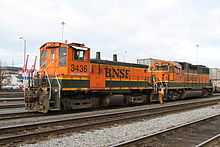Remote control locomotive

A remote control locomotive is a railway vehicle that provides the motive power for a train that differs from a conventional locomotive in that remote control radio transmitter and receiver system is used to operate it, by a person not physically located at the controls within the confines of the locomotive cab.[1] They have been in use for many years in the railroad industry, including industrial applications such as bulk material load-out, manufacturing, process and industrial switching. The systems are designed to be fail-safe so that if communication is lost the locomotive is brought to a stop automatically.[1]
History
In the United States remotely controlled locomotives have been in use since the 1980s. In 1988, the Occupational Safety and Health Administration issued a Hazard Information Bulletin regarding their use.[2] By 1999 Canadian National Railway had 115 locomotives equipped with remote control equipment, covering 70% of flat-yard switching and all of its hump yard operations. Canadian National estimated a savings of CDN$20 million per year vs. traditional switching operations.[3]
The Brotherhood of Locomotive Engineers and Trainmen has expressed concerns about remote control locomotives. The union stated that remote control locomotives are not as efficient as traditional engineer-in-cab switching operations while being more dangerous.[4]
In 2001, the Federal Railroad Administration (FRA) recommended minimal guidelines for the operation of remote control locomotives.[5]
The Union Pacific Railroad has developed remote-control enabling locomotives it refers to as Control Car Remote Control Locomotives. CCRCL's are stripped-down locomotives fitted with remote control equipment. CCRCL's have no motive power and must be coupled to a standard locomotive.[6]
Locotrol is a product of GE Transportation Systems that enables distributed power sending signals from the lead locomotive to the remote units via radio control. Locotrol is installed on more than 8,500 locomotives around the world.[7] Users of the system include BHP Iron Ore, Westrail and Queensland Rail in Australia.[8][9][10]
Terms
Acronyms used within RCL operations
- RCL - Remote Control Locomotive
- LRC - Locomotive Remote Control
- FRA - Federal Railroad Administration
- RCO - Remote Control Operator
- RCU - Remote Control Receiver
- OCU - Operator Control Transmitter
- RCT - Remote Control Transmitter
- AAR - Association of American Railroads
- ASLRRA - American Shortline Railroad Association
- WMUCS - Wireless Multiple Unit Coupler
- DPCS - Distributed Power Control System
Other terms
- Belly Box - OCU or transmitter attached to a support vest
- Receiver - RCU Remote control systems that receives coded messages from the transmitter (OCU) and commands the locomotive to operate
See also
References
- ↑ 1.0 1.1 "Safety: Remote Control Locomotive Operations". Federal Railroad Administration. Retrieved 2008-11-16.
- ↑ "Remote Control Plant Locomotives". OSHA Hazard Information Bulletin 19880808. Occupational Safety and Health Administration. Retrieved 2008-11-16.
- ↑ Luther S. Miller (February 1999). "Locomotive remote control - A prize just out of reach". Railway Age. www.railwayage.com. Retrieved 2008-11-16.
- ↑ Brotherhood of Locomotive Engineers and Trainmen Auxiliary. "Remote Control Locomotives". www.bletauxiliary.net. Retrieved 2008-11-16.
- ↑ FRA. "Recommended minimal guidelines for the operation of remote control locomotives". www.fra.dot.gov. Retrieved 2010-02-07.
- ↑ Sean Graham-White. "UP CCRCL's". www.trainweb.org. Retrieved 2008-11-16.
- ↑ "Locomotive Products : Onboard Systems : LOCOTROL Distributed Power". GE Transportation - North America. www.getransportation.com. Retrieved 2008-11-16.
- ↑ William C. Vantuono (April, 2002). "Control this! how distributed power helps railroads handle the world's longest, heaviest trains. demonstration union train - BHP Iron Ore Australia". Railway Age. findarticles.com. Retrieved 2008-11-16.
- ↑ "Locotrol Workings". djukin.tripod.com. Retrieved 2008-11-16.
- ↑ "Railways in the Coal Fields of Queensland". Technology in Australia 1788-1988. www.austehc.unimelb.edu.au. p. Chapter 6, page 382. Retrieved 2008-11-16.